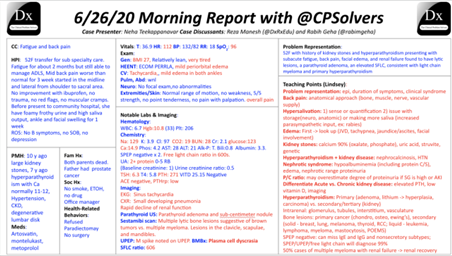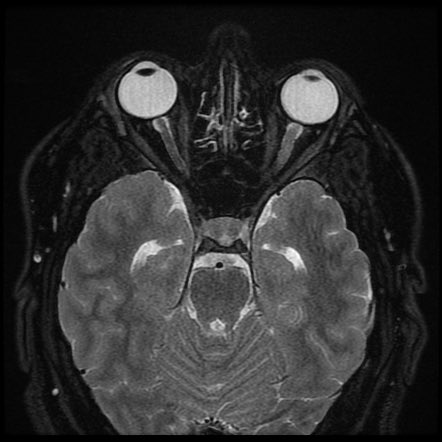Time for some #SpacedRepetition: @CPSolvers
Chat recap of the #ClinicalPearls #VirtualMorningReport
June 26th Day 83: clinicalproblemsolving.com/morning-report…
w/ Neha Teekappanavar @DxRxEdu @rabihmgeha
Case Overview by @LindseyShipley8
Chat recap of the #ClinicalPearls #VirtualMorningReport
June 26th Day 83: clinicalproblemsolving.com/morning-report…
w/ Neha Teekappanavar @DxRxEdu @rabihmgeha
Case Overview by @LindseyShipley8

Let's start with an initial problem representation:
A 52 y/o F presents with 2 months of fatigue, 3 wks of mid back pain, foamy urine, hypersalivation, and swelling in her ankle and face
A 52 y/o F presents with 2 months of fatigue, 3 wks of mid back pain, foamy urine, hypersalivation, and swelling in her ankle and face
Enter ITAMED:
would look for systemic symptoms like weight loss, night sweats
Back pain age over 50 is a red flag to image
frothy urine...nephrotic?
foamy urine can indicate proteinuria although non-specific
clinical significance of foamy urine?ncbi.nlm.nih.gov/pmc/articles/P…
would look for systemic symptoms like weight loss, night sweats
Back pain age over 50 is a red flag to image
frothy urine...nephrotic?
foamy urine can indicate proteinuria although non-specific
clinical significance of foamy urine?ncbi.nlm.nih.gov/pmc/articles/P…
In the study cited above, Of the 72 patients w/ foamy urine, 22.2% had overt proteinuria & that dm, poor renal function (🔼Cr, BUN, 🔽eGFR), 🔼serum phosphate, &🔼 serum glucose were associated w/ overt proteinuria
I don’t think anybody has an illness script for increased saliva
I don’t think anybody has an illness script for increased saliva
sialorrhea. is there a toxidrome? cholinergic
hypersalivation from rabies ncbi.nlm.nih.gov/pmc/articles/P…
the ankle and facial swelling could be the result of a kidney injury. Similar to PSGN
multiple myeloma with proteinuria on back of someones mind as it can cause nephrotic syndrome
hypersalivation from rabies ncbi.nlm.nih.gov/pmc/articles/P…
the ankle and facial swelling could be the result of a kidney injury. Similar to PSGN
multiple myeloma with proteinuria on back of someones mind as it can cause nephrotic syndrome
On PE we also need to distinguish from bony tenderness vs paraspinal muscle pain for her midline tenderness
if it’s truly proteinuria would be helpful to do age appropriate cancer screening, hepatitis test for membranous nephropathy
obesity, HIV, IVDU are risk factors for FSGS
if it’s truly proteinuria would be helpful to do age appropriate cancer screening, hepatitis test for membranous nephropathy
obesity, HIV, IVDU are risk factors for FSGS
Thrombosis from nephrotic syndrome can cause back pain
Talking of thrombosis it can be PNH causing thrombosis in unlikely places
Thromboembolism is the MCC of mortality in patients w/ PNH & accounts for approx 40%-67% of deaths ashpublications.org/blood/article/…
Talking of thrombosis it can be PNH causing thrombosis in unlikely places
Thromboembolism is the MCC of mortality in patients w/ PNH & accounts for approx 40%-67% of deaths ashpublications.org/blood/article/…
Is the hypercalcemia a PIVOT POINT
persistent hyperCa can cause polyuria (nephrogenic DI)
Hypercalcemia = bone pain and nephrotic syndrome?
struggling to fit in the salivation, feel like that may be related somehow.. other than large mass in the neck causing swallowing obstruc
persistent hyperCa can cause polyuria (nephrogenic DI)
Hypercalcemia = bone pain and nephrotic syndrome?
struggling to fit in the salivation, feel like that may be related somehow.. other than large mass in the neck causing swallowing obstruc
Hypercalcemia: Stones bones, moans and psychiatric overtones
Check out the @runthelistpod handout on HyperCa, runthelistpodcast.com/s/RTL_Hypercal…
PTH is also know as the phosphate trashing hormone
Could this be X-linked hypophosphatemic rickets, rarediseases.info.nih.gov/diseases/12943…
Check out the @runthelistpod handout on HyperCa, runthelistpodcast.com/s/RTL_Hypercal…
PTH is also know as the phosphate trashing hormone
Could this be X-linked hypophosphatemic rickets, rarediseases.info.nih.gov/diseases/12943…
We are still stuck on the hypersalivation...Noise?
as any invasion of salivary glands by amyloid or inflammation should cause hyposalivation
Paging Dr. Hickam!!!
protein to creatinine ratio of 0.5
Urine protein Cr ratio is helpful to see if missing BJ proteins
as any invasion of salivary glands by amyloid or inflammation should cause hyposalivation
Paging Dr. Hickam!!!
protein to creatinine ratio of 0.5
Urine protein Cr ratio is helpful to see if missing BJ proteins
The urine protein to cr ratio OVERestimates
no nephrotic syndrome
And she has a very elevated PTH, (PTH Dependent) likely causing the hypercalcemia
Diagnosis and management of parathyroid cancer, nature.com/articles/nrend…
no nephrotic syndrome
And she has a very elevated PTH, (PTH Dependent) likely causing the hypercalcemia
Diagnosis and management of parathyroid cancer, nature.com/articles/nrend…
whenever you look for MM order spep AND free light chains (nowadays FLC replaced UPEP)
osteitis fibrosa cystica is so rare these days as it is seen in the setting of long-standing hyperPTH
is a skeletal disorder caused by a surplus of PTH from overactive parathyroid gland
osteitis fibrosa cystica is so rare these days as it is seen in the setting of long-standing hyperPTH
is a skeletal disorder caused by a surplus of PTH from overactive parathyroid gland

Osteitis fibrosa cystica—a forgotten radiological feature of primary hyperparathyroidism, ncbi.nlm.nih.gov/pmc/articles/P…
the MASSIVE decline in her kidney function is due to light chains
this is called protein cast nephropathy, “myeloma kidney,” ncbi.nlm.nih.gov/pmc/articles/P…
the MASSIVE decline in her kidney function is due to light chains
this is called protein cast nephropathy, “myeloma kidney,” ncbi.nlm.nih.gov/pmc/articles/P…
Her US thyroid w/ possible adenine & subcm cystic nodule; sestamibi with no spot uptake, but did show multiple osteopathic lesions in clavicle, scapulae, mandibles
brown tumors can occur in clavicles, distally more typical
Makes sense, her Ca is just too high for pure hyperpara
brown tumors can occur in clavicles, distally more typical
Makes sense, her Ca is just too high for pure hyperpara
Usually primary hyperparathyroidism does not cause calcium greater than 14
She had no Gamma Gap...
u might not always see a gamma gap especially when it’s been present for a prolonged period of time
She had no Gamma Gap...
u might not always see a gamma gap especially when it’s been present for a prolonged period of time
One thing to think about with serum light chains is the often in kidney disease you can get a mildly elevated kappa to lambda ratio. Usually, a ratio >3.5 in renal insufficiency is significant though.
Final Dx: Parathyroid adenoma, light chain myeloma & primary hyperparathyroid
Final Dx: Parathyroid adenoma, light chain myeloma & primary hyperparathyroid
When thinking about hyperCa, usually the mechanism of causing renal disease is a diuresis leading to dehydration, the edema did not fit (could consider the development of an ATN).
It is always good to further investigate when all the pieces do not fit
It is always good to further investigate when all the pieces do not fit
https://twitter.com/AnnKumfer/status/1277369038671417344
SPEP neg can miss IgE and IgG & non secretory types
SPEP/UPEP/Free light chains will dx 99%
50% of MM w/ renal failure will recover
Teaching points by @sukritibanthiya: clinicalproblemsolving.com/wp-content/upl…
SPEP/UPEP/Free light chains will dx 99%
50% of MM w/ renal failure will recover
Teaching points by @sukritibanthiya: clinicalproblemsolving.com/wp-content/upl…

@GurleyGuy @AndreaAnampaG @AnthonyPensa @lakh_malla @PGuptaMD @YihanYangMD @DanielCLiauw @ASanchez_PS @AbelJosephMD @BrentChamMD @AndreaAnampaG @this_is_svenka @SurajNagaraj @dminter89 @Doc_Fomin @AnnKumfer @DoubleDawgMD @Anand_88_Patel @MikeRoseMDMPH @haematognomist
@matstomato @AnandJag1 @StephVSherman @MargaretL16 @aoglasser @ETSshow @gradydoctor @MohitHarshMD @HannahRAbrams @SmithaGaneshan @jackpenner @TheRealDSrini @MattSakumoto @medrants @RachelBigley1 @k_vaishnani @MeerkatMirson @matstomato @zoyaqureshy @tony_breu @ddeng_22
@Sharminzi @ArsalanMedEd @ecvasti @JonathanRyderMD @RezidentMD @GurleyGuy @appyjumpindaze @justalisongrace @DavidTHLam @BethGay45 @BrandonKinneman @rongejman @BryanCUlrich @victorekuta @danaamara1 @NishaSunkuMD @pri_athavale @BhavyaVarma12 @sargsyanz @StephVSherman
@appyjumpindaze @noahrosenberg @JFBirnbaum @chioma_ndukweau @andressa__k @PeytonNesmith @blairgolden @BP76104 @Gurpreet2015 @mBohlega @INizamuddinMD @AlexHorneMD @EricaLCrosley @AJ_Kurtzman @miniisms @dsouzl @AaronLTroy @danielgauvin07 @AdamLongMD @d_dressler92 @Chris_Lees_
@tmodarressi @DanielleEngskow @AnneArnason @AmandaGarfinkel @mBohlega @Tapatio117 @DoctorVig @travishughes @activist_doc @franklybryan @_HarryPaul_ @Baker_C23 @FZghyer @RamlaKasoziMD @_blake_smith @LizzyHastie @AzeemRathore_ @AchantaAditya @Jcortesizaguirr @ShrutiKoti
@Azooz_Asbeutah @saipeeps @JordanSell22 @RizwanDania @Kaitlyn_Rogers9 @LawrenceWuMD @buckeye_sanjay @dmottacalderon @vikramagn @maheen_ihsan @efloyd14 @cobbnotgrey @Azooz_Asbeutah @onsarigo93 @Dayyan95 @tarheel_doctor @Anouf14 @VCU_IMRes @coyefish379 @amrmousa96 @Elizabe19893579
@Gurleen_Kaur96 @AshleyGWallace @Vandylism @RWBonner91 @abhiappukutty @PeguyTelusma @3owllearning @arturohdez_i @PaulKunnath @medrachel @sukritibanthiya @abdallah_tom @OpsBug @fernandbteich @LindseyShipley8 @OpsBug @smalltownOMS @sathya27024741 @SwainNordstrom
• • •
Missing some Tweet in this thread? You can try to
force a refresh






